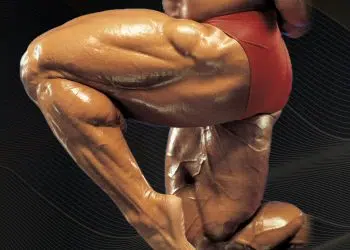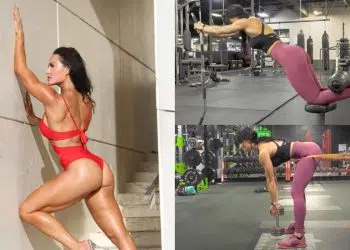A lot of exercisers are unhappy with their hamstring development. As a personal trainer with over 30 years of experience, I usually put this down to a lack of variation. After all, when it comes to hamstring training, most people rely on leg curls and Romanian deadlifts to get the job done.
While both of these exercises can be effective, you can have too much of a good thing. Doing the same exercises over and over will eventually become repetitive and boring, making your workouts less productive.
The good news is that there are plenty of alternative exercises you can use to build and strengthen your leg biceps.
Adding these exercises to your leg workouts will enhance motivation, help unstick your progress, and get you back on the gains train (1). As an added benefit, working on your hamstring strength will also reduce your risk of injury, which is an important consideration for athletes and recreational exercisers alike (2).
In this article, I reveal seven cruel and unusual exercises that I guarantee will make your hamstrings cry for mercy!
7 New Exercises for Stronger, More Muscular Hamstrings
Level Up Your Fitness: Join our 💪 strong community in Fitness Volt Newsletter. Get daily inspiration, expert-backed workouts, nutrition tips, the latest in strength sports, and the support you need to reach your goals. Subscribe for free!
Breathe new life into your leg workouts with these tried and tested exercises for bigger, stronger hamstrings. My army of personal training clients love them, and I’m sure you will, too. However, prepare for some muscle soreness tomorrow – these are gonna hurt!
1. Banded Leg Curl
Most people are familiar with seated, prone, and standing leg curls. They’re gym staples and arguably the most popular hamstring exercises. However, switching from weights to a resistance band will hit your hammies in an all-new way, triggering new strength and growth. This is also an excellent variation for home workouts.
How to do it:
- Attach a loop-type band to a low anchor, e.g., a pillar or post.
- Sit on the floor and put your feet through the loop.
- Lie on your front and, with straight legs, shuffle forward to tension the band.
- Keeping your hips on the floor and core braced, bend your legs and pull your feet into your butt. Try to touch your hamstrings with your calves.
- Slowly extend your legs and repeat.
Tips:
- Shuffle further forward to increase the tension on the band and make this exercise harder. Move back toward the anchor to make it easier.
- You can also do this exercise using one leg at a time.
- Place a foam pad or folded gym mat under your hips for comfort.
2. Single-leg Landmine Romanian Deadlift
Unilateral or single-leg exercises should be part of everyone’s lower body workout. Training one leg at a time ensures balanced muscular development and equal strength.
Also, because many of life’s strenuous activities happen one leg at a time, single-leg exercises are often more functional than their bilateral counterparts. Single-leg landmine RDLs are a very effective leg exercise. However, you don’t need the balance of a gymnast to do them.
How to do it:
- Stand sideways onto your landmine bar. Squat down and grab it with your nearest hand. Brace your core, pull your shoulder back and down, and stand up.
- Shift your weight over onto your outside leg. Bend your knees slightly for stability and balance.
- Hinging from the hips, lean forward and extend your opposite leg out behind you.
- Stand back up straight and repeat.
- Perform the required number of reps and then switch sides. Do the same number of reps on the opposite leg.
Tips:
- Hold one end of a barbell with the other end wedged in a corner if you don’t have a landmine device.
- You can also do two-legged landmine RDLs if you want to lift more weight.
- Use a B or kickstand stance for more balance if necessary.
3. Band-Assisted Nordic Curls
Nordic curls are a challenging hamstring exercise. Unfortunately, many people find them too hard to perform safely or correctly. That said, studies suggest they’re effective for building muscle and preventing injury (3), and using a band for assistance makes this exercise easier and much more accessible.
How to do it:
- Attach a loop-type resistance band to a strong overhead anchor, e.g., a squat rack crossbar or roof beam. Place the band under your arms and around your chest.
- Kneel down on a foam pad or folded gym mat for comfort and anchor your feet. Your knees, hips, and shoulders should form a straight line.
- Brace your core and engage your glutes.
- Using your hamstrings as brakes, lower your body down toward the floor. Place your hands out in front of you to control your descent.
- Push with your arms, pull with your hammies, and return to the starting position.
- That’s one rep – keep going!
Tips:
- Graduate to a weaker band as your hamstrings get stronger.
- Use your arms less and your hamstrings more to increase the overload on the target muscles.
- Lean forward at the hips to make this exercise easier.
4. Dumbbell Hamstring Walk
Home exercisers are often left wondering how best to work their hamstrings. After all, unless you have an awesome home gym, your workouts will probably revolve around dumbbells and bodyweight exercises. This simple exercise is surprisingly effective and hits your glutes and hammies at the same time.
Level Up Your Fitness: Join our 💪 strong community in Fitness Volt Newsletter. Get daily inspiration, expert-backed workouts, nutrition tips, the latest in strength sports, and the support you need to reach your goals. Subscribe for free!
How to do it:
- Lie on your back with your legs straight and arms by your sides. Rest your heels on a dumbbell.
- Brace your core, clench your glutes, and lift your hips a few inches off the floor.
- Bend your legs and, step by step, roll the dumbbell toward your butt while simultaneously lifting your hips.
- Slowly return to the starting position and repeat.
Tips:
- Lift your hips as high as possible without hyperextending your lumbar spine.
- Use your arms to help you lift your hips if necessary.
- You can also do this exercise with a stability ball or medicine ball.
5. Prone Medicine Ball Leg Curl
This exercise was a staple of my training as a young athlete. Not only is it low-tech but high-effect, but it also develops explosive power and kinesthetic awareness. While you will need a partner for this hamstring move, it’s worth it if you want an alternative to conventional leg curls.
How to do it:
- Lie on your front with your head resting on your folded arms. Your legs should be straight and together.
- Ask your partner to stand astride your hips while facing your feet.
- When ready, tell your partner to roll the ball down your legs.
- As the ball reaches your calves, bend your legs and curl the ball back up to your partner’s outstretched hands.
- Lower your legs and repeat for the desired number of reps.
Tips:
- This exercise is easier with a large-diameter medicine ball. Small balls tend to roll off the side of your legs.
- Try to heel-kick the ball up your legs to maximize muscle power.
- Ensure your training partner remains attentive and catches the ball as it’s returned to them. A missed catch can result in severe injury.
6. Hip Band Romanian Deadlift
I have nothing against regular barbell and dumbbell Romanian deadlifts. After all, they’re classic leg exercises. However, I also recognize that doing them too often can become boring, which is why I like to mix things up from time to time. This clever RDL variation challenges your hamstrings in an unusual way, making it ideal for reigniting hamstring growth.
How to do it:
- Attach a loop-type resistance band to a low anchor, such as the bottom of a squat rack or a heavy dumbbell on the floor.
- Place a barbell on the floor a few feet in front of the band.
- Stand in the band loop with your feet about hip-width apart. Loop the band around your hips. Grab the barbell and stand up straight with a slight bend in your knees.
- Hinging from the hips, lean forward while simultaneously reaching back with your butt.
- Drive your hips forward against the resistance of the band and stand up.
- Continue for the desired number of reps.
Tips:
- Do not round your lower back, as doing so could cause injury.
- Do this exercise with dumbbells if preferred.
- Raise your toes on weight plates to increase hamstring engagement further.
7. Single-Leg Isometric Hamstring Bridge
Isometric exercises involve a static contraction of the target muscles. Most isometric exercises involve little or no equipment. But, despite this, they’re effective for building muscle size and strength while being kind to your joints. Isometrics make ideal finishers after your more dynamic exercises.
How to do it:
- Lie on your back with your legs straight.
- Place your heels on a bench or step. Brace your abs and clench your glutes. Raise one leg up.
- Drive your opposite heel into your platform and lift your hips off the floor. Pull your foot toward your butt to slightly bend your knee.
- Maintain this position until your muscles begin to fatigue.
- Lower your hips to the floor, switch legs, and repeat.
Tips:
- Use two legs instead of one to make this exercise a little easier.
- Experiment with different knee angles to determine what feels most comfortable and effective.
- You can do this exercise by contracting as hard as possible for 10-20 seconds or less forcefully for 40-60 seconds. Either option works well, so try both.
Here are some other ways to supercharge your workouts with isometrics.
Closing Thoughts
Your hamstrings are a biaxial muscle, meaning they cross two joints – your hips and your knees. As such, they affect both these joints and are responsible for two different actions: hip extension and knee flexion.
Because of this anatomical feature, you need to include hip extension AND knee flexion exercises in your leg workouts. This will ensure you develop all available muscle fibers while maximizing strength and function.
So, don’t just limit yourself to leg curls or Romanian deadlifts – do both!
Better yet, build your leg workouts around the exercises in this article, remembering to include knee and hip dominant movements for more complete muscle development.
And remember, there is nothing inherently wrong with conventional leg curls or RDLs. However, boredom could be undermining your muscle and strength-building progress. So, mix things up with these seven new exercises to keep your workouts fresh and interesting and keep those gains coming.
Related: The Best Hamstring Workout for Monster Leg Biceps
References:
- Baz-Valle E, Schoenfeld BJ, Torres-Unda J, Santos-Concejero J, Balsalobre-Fernández C. The effects of exercise variation in muscle thickness, maximal strength and motivation in resistance-trained men. PLoS One. 2019 Dec 27;14(12):e0226989. doi: 10.1371/journal.pone.0226989. PMID: 31881066; PMCID: PMC6934277.
- Raya-Gonzalez J, Castillo D, Clemente FM. Injury prevention of hamstring injuries through exercise interventions. J Sports Med Phys Fitness. 2021 Sep;61(9):1242-1251. doi: 10.23736/S0022-4707.21.11670-6. Epub 2021 Jan 22. PMID: 33480508.
- Al Attar WSA, Soomro N, Sinclair PJ, Pappas E, Sanders RH. Effect of Injury Prevention Programs that Include the Nordic Hamstring Exercise on Hamstring Injury Rates in Soccer Players: A Systematic Review and Meta-Analysis. Sports Med. 2017 May;47(5):907-916. doi: 10.1007/s40279-016-0638-2. PMID: 27752982.










I would add lying leg curls in TRX here